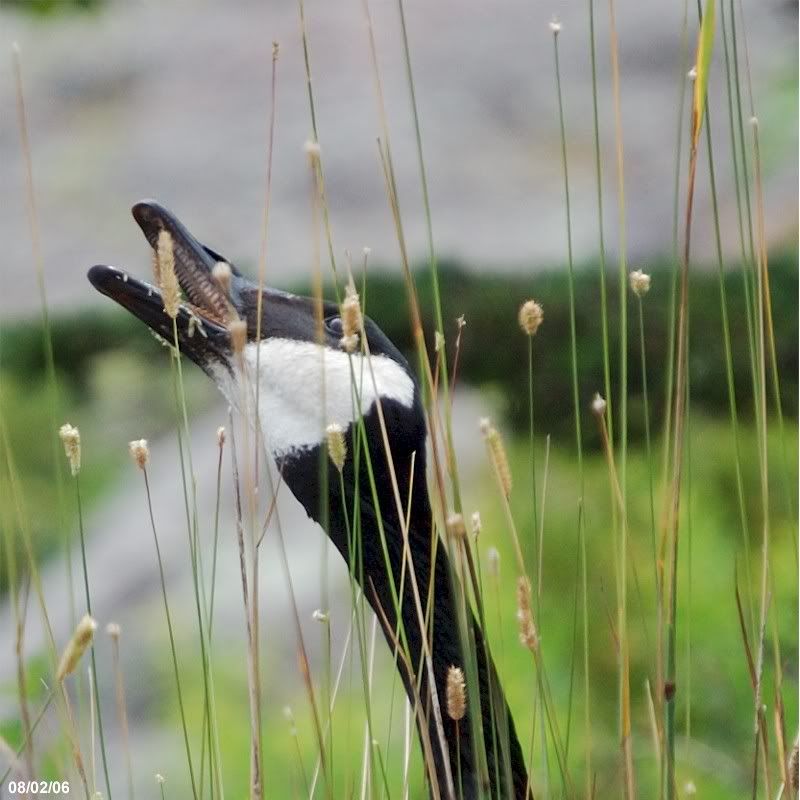From a Oct 22 NYT Article on proper killing and cooking of Canada Geese: Don’t Landfill That Goose. Braise It. The key to delicious Canada goose, Jackson Landers says, begins at the moment of death. “When people taste a Canada goose and say ‘this is terrible,’ ” Mr. Landers said, “usually when you track down the history of how the animal was taken and butchered, you might have an animal that’s gut shot and left to sit for a few hours in the back of a truck. If you handled a cow or a domestic chicken the way that a lot of hunters handle their meat, it would taste gamy and vile as well.” Mr. Landers, a hunting instructor and locavore activist based in Virginia, knows whereof he speaks. He has written a book on deer hunting and is working on a second book, and, he hopes, a reality television show (see trailer below), called “Eating Aliens,” about eating invasive species. …With the help of a Brooklyn chef, Leighton Edmondson, Mr. Landers will cook and serve the geese — paired with New York State wines, of course — at a two-hour workshop under the auspices of Slow Food NYC. …“If someone’s going to eat meat,” Mr. Landers said, “that’s at least better than putting an animal in a dark cage for its entire life indoors, cutting off its beak, pumping it full of steroids and then killing it.”
Jackson Landers’s workshop, “The Locavore Hunter — Geese Gone Wild!” is Saturday, Oct. 30, from noon to 2:30 p.m. at Ger-Nis Culinary and Herb Center, 540 President Street, Suite 2A, in Park Slope, Brooklyn. Tickets are $35 for nonmembers of Slow Food NYC and $25 for members, available from Brown Paper Tickets.
(video via Michael Galinsky)
(thanks to Mary Ann Newman for sending article)
Taproot
Been thinking a bit about taproots as a good model for stubborn ideas.
A taproot is an enlarged somewhat straight to tapering plant root that grows vertically downward. It forms a center from which other roots sprout laterally.[1]

The taproot of Carrots.
Plants with taproots are difficult to transplant. The presence of a taproot is why dandelions are hard to uproot — the top is pulled, but the long taproot stays in the ground, and re-sprouts.
Most plants start with a taproot,[2] which is one main root forming from the enlarging radical of the seed. The tap root can be persistent through out the life of the plant but is most often replaced later in the plants development by a fibrous root system.[2][3]A persistent taproot system forms when the radical keeps growing and smaller lateral roots form along the taproot; often the radical dies some after seed germination causing the development of a fibrous root system which lacks one main downward growing root. Most trees begin life with a taproot,[3] but after one to a few years the main root system changes to a wide-spreading fibrous root system with mainly horizontal growing surface roots and only a few vertical, deep anchoring roots. A typical mature tree 30–50 m tall has a root system that extends horizontally in all directions as far as the tree is tall or more, but well over 95% of the roots are in the top 50 cm depth of soil.
– thanks wikipedia
Bird communication
Great web page full of info and clips on bird communication from Gary Ritchison’s Avian Biology course at EKU (ta, google)
bird communication |
avian biology
and then there’s this…
The Contemporary Condition: Fragile
“I don’t for a second buy into the story, promoted both by deep greens and by the right, that Mother Earth will just brush us off and recover. Faith in an all-powerful deity is precisely a way to ignore hyperobjects. Some people commented on my previous post on hyperobjects, wondering whether God could be considered as one. No. It is precisely when we start to notice hyperobjects that the idea of some transcendental beyond, inhabited by an all-powerful being, starts to melt, and we humans break loose from our island of certainty to float on the ocean of science.How arrogant of us to think that we had reached the end of history in 1989. And how brittle of us. Little did we want to know how this posturing was actually a symptom of our own fragility. The good news is that we are at the beginning of history, like an exhausted newborn, stunned and breathing heavily outside the womb of concepts such as Nature and Progress.”
– Timothy Morton from the blog, The Contemporary Condition
the scrubby, feral and untended
Important article from Nature on the importance of looking at non-native, hybrid, “impure” ecosystems: Ragamuffin Earth (July 2009).
Excerpted:
Most ecologists and conservationists would describe this forest in scientific jargon as ‘degraded’, ‘heavily invaded’ or perhaps ‘anthropogenic’. Less formally, they might term it a ‘trash ecosystem’. After all, what is it but a bunch of weeds, dominated by aggressive invaders, and almost all introduced by humans? It might as well be a city dump.
A few ecologists, however, are taking a second look at such places, trying to see them without the common assumption that pristine ecosystems are ‘good’ and anything else is ‘bad’. The non-judgemental term is ‘novel ecosystem’. A novel ecosystem is one that has been heavily influenced by humans but is not under human management. A working tree plantation doesn’t qualify; one abandoned decades ago would. A forest dominated by non-native species counts… even if humans never cut it down, burned it or even visited it.
No one is sure how much of Earth is covered by novel ecosystems.



